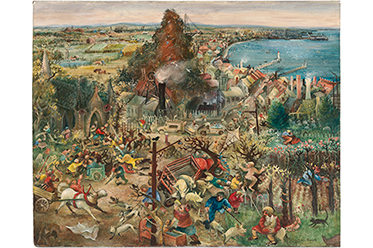 The first major exhibition of Arthur Boyd’s art in over twenty years, Agony & Ecstasy includes more than 180 spectacular works of art including paintings, tapestries, prints, drawings, sculptures and ceramics.
The first major exhibition of Arthur Boyd’s art in over twenty years, Agony & Ecstasy includes more than 180 spectacular works of art including paintings, tapestries, prints, drawings, sculptures and ceramics.
The focus of the exhibition is on Boyd as an intense, passionate visionary capable of plumbing the depths and vicissitudes of human emotions. The show is not a retrospective but rather provides the opportunity to take a close look at a number of works that have never or rarely been previously exhibited, as well as series and groups of works, undertaken from 1937 through to 1980.
While the Australian landscape informs some works, the emphasis is on the way that Boyd engages with human experience—starting with an intense early self-portrait painted when he was only seventeen through to works of great potency undertaken four decades later. Including intimate as well as expansive works, the sheer scale of many of them mean that this is a once in a lifetime opportunity to see them together.
While the public are perhaps very familiar with Boyd’s works from the 1940s and 50s, the exhibition also seeks to emphasise the strengths of his art created in the 1960s and 70s.
“We are delighted to present Arthur Boyd: Agony & Ecstasy at the National Gallery of Australia this spring. The exhibition presents a new and distinctive look at the work of one of Australia’s most accomplished, innovative and of course, famous artists”, said Ron Radford AM, Director, National of Gallery of Australia.
“The exhibition reveals Boyd’s capacities to work across a wide range of media in ways that are at times highly considered and at others highly inventive and intuitively spontaneous. Arthur Boyd: Agony & Ecstasy displays his paintings, including part of his mural, his prints, drawings, theatre designs, sculptures and tapestries. In many ways here is the unseen Arthur Boyd, the uncensored Boyd. The raw power of many of these works is not for the faint-hearted.”
The exhibition is extensive and includes important series such as the dramatic, biblical Nebuchadnezzar paintings, exquisite prints and large tapestries on the theme of The lady and the unicorn, lively costume designs for the ballet Elektra (choreographed by Robert Helpmann in 1963) and his remarkable Caged painter series. A special room has also been constructed for Boyd’s visionary images on the life of St Francis, including prints and pastels as well as a dazzling group of large-scale tapestries not previously exhibited together.
“By considering diverse series in depth, it is possible to see the interplay of ideas across a particular theme, revealing Boyd’s remarkable powers of invention,” says said exhibition Curator Deborah Hart. “Looking across forty years of work in many media reveals him to be one of the most stylistically diverse and accomplished artists nationally and internationally.”
“Boyd received much acclaim in his lifetime yet he always retained a sense of humility and concern for the suffering of others. From works of the late 1930s through to his series on the life of Saint Francis decades later, he continually wrestled with ideas of good and evil, love and compassion, loss and reclamation.”
Among the many works that have not been exhibited before is The prodigal son, a large fragment of a mural that was painted by Arthur for his uncle, the well-known novelist, Martin Boyd. Undertaken in 1948, its original location was the dining room of a house known as The Grange, built by his great grandparents in 1866 at Harkaway near Berwick in Victoria.
Sadly, The Grange was eventually demolished to make way for a quarry. After years of thwarted attempts to save the mural, four relatively large components and several small sections were saved and eventually came to the National Gallery of Australia.
Arthur Boyd: Agony & Ecstasy
National Gallery of Australia, Parkes Place, Parkes (Canberra)
Exhibition continues to 9 November 2014
Entry fees apply
For more information, visit: www.nga.gov.au for details.
Image: Arthur Boyd, The mining town (Casting the money lenders from the temple) c.1946, oil and tempera on composition board, 87.4 x 109.4 cm, National Gallery of Australia, Canberra, Purchased 1974, Reproduced with the permission of Bundanon Trust
